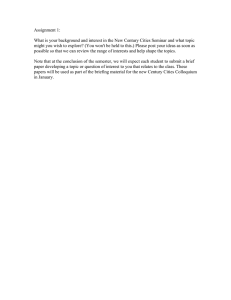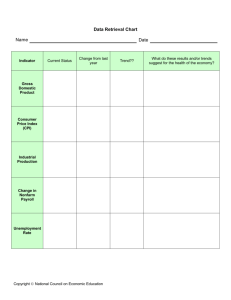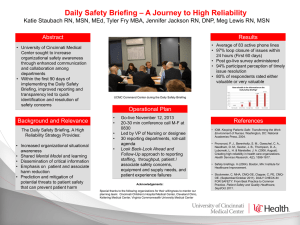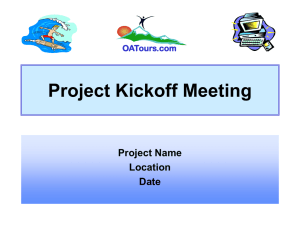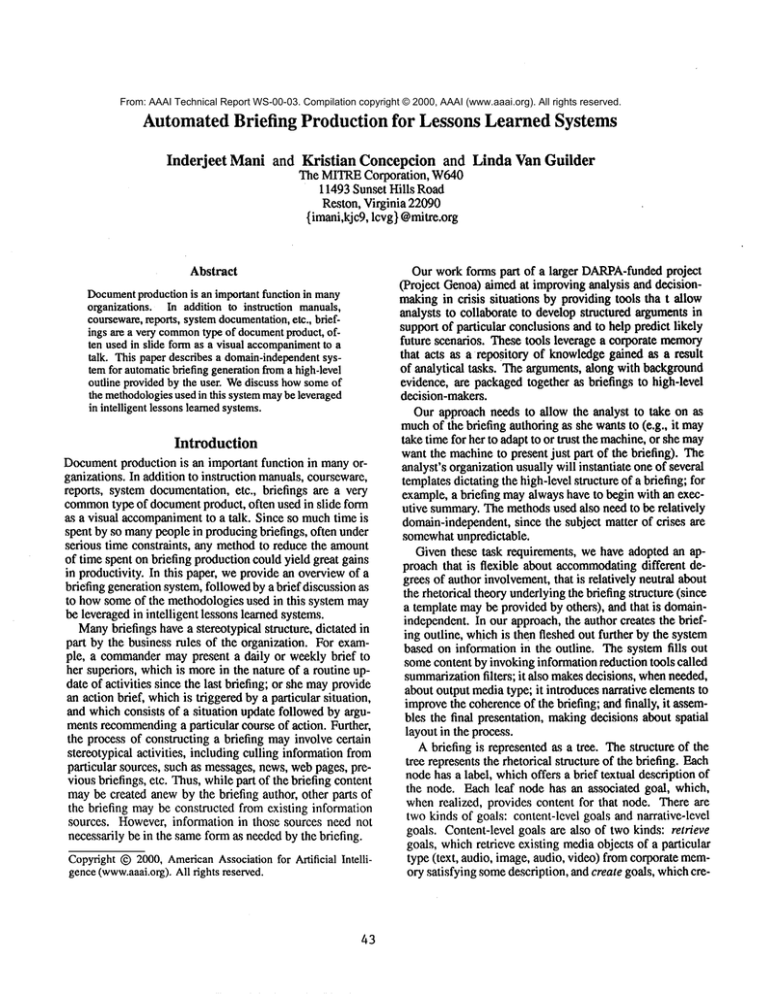
From: AAAI Technical Report WS-00-03. Compilation copyright © 2000, AAAI (www.aaai.org). All rights reserved.
AutomatedBriefing Production for Lessons LearnedSystems
Inderjeet
Mani and Kristian
Concepcion and Linda Van Guilder
The MITRECorporation, W640
11493Sunset Hills Road
Reston, Virginia 22090
{imani,kjc9,lcvg} @mitre.org
Abstract
Document
productionis an importantfunctionin many
organizations.In addition to instruction manuals,
courseware,
reports,systemdocumentation,
etc., briefings are a verycommon
type of document
product,often usedin slide formas a visual accompaniment
to a
talk. Thispaperdescribesa domain-independent
systemfor automatic
briefinggenerationfroma high-level
outline providedbythe user. Wediscusshowsomeof
the methodologies
usedin this systemmaybe leveraged
in intelligentlessonslearnedsystems.
Introduction
Document
productionis an important function in manyorganizations.In additionto instruction manuals,courseware,
reports, systemdocumentation,etc., briefings are a very
common
type of documentproduct, often used in slide form
as a visual accompaniment
to a talk. Since so muchtime is
spent by so manypeoplein producingbriefings, often under
serious time constraints, any methodto reduce the amount
of time spent on briefing productioncould yield great gains
in productivity. In this paper, weprovidean overviewof a
briefing generationsystem,followedby a brief discussionas
to howsomeof the methodologiesused in this systemmay
be leveragedin intelligent lessonslearnedsystems.
Many
briefings havea stereotypicalstructure, dictated in
part by the business rules of the organization. For example, a commander
maypresent a daily or weeklybrief to
her superiors, whichis morein the nature of a routine update of activities since the last briefing; or she mayprovide
an actionbrief, whichis triggeredby a particular situation,
and whichconsists of a situation update followedby argumentsrecommending
a particular courseof action. Further,
the process of constructing a briefing mayinvolve certain
stereotypicalactivities, includingculling informationfrom
particular sources,such as messages,news,webpage~s,previousbriefings, etc. Thus,whilepart of the briefingcontent
maybe created anewby the briefing author, other parts of
the briefing maybe constructed fromexisting information
sources. However,information in those sources need not
necessarilybe in the sameformas neededby the briefing.
Copyright©2000,American
Associationfor Artificial Intelligence(www.aaai.org).
All rights reserved.
43
Our workforms part of a larger DARPA-funded
project
(Project Genoa)aimedat improvinganalysis anddecisionmakingin crisis situations by providingtools tha t allow
analysts to collaborate to developstructured argumentsin
supportof particular conclusionsandto help predict likely
future scenarios. Thesetools leverage a corporate memory
that acts as a repository of knowledge
gained as a result
of analytical tasks. Thearguments,along with background
evidence,are packagedtogether as briefings to high-level
decision-makers.
Ourapproachneeds to allow the analyst to take on as
muchof the briefing authoringas she wantsto (e.g., it may
take time for her to adaptto or trust the machine,or she may
wantthe machineto present just part of the briefing). The
analyst’sorganizationusuallywill instantiate oneof several
templatesdictatingthe high-levelstructureof a briefing;for
example,a briefing mayalwayshaveto begin with an executive summary.
Themethodsused also needto be relatively
domain-independent,
since the subject matter of crises are
somewhat
unpredictable.
Giventhese task requirements, wehave adoptedan approachthat is flexible about accommodating
different degrees of authorinvolvement,
that is relatively neutral about
the rhetorical theoryunderlyingthe briefingstructure (since
a templatemaybe providedby others), and that is domainindependent.In our approach,the author creates the briefing outline, whichis then fleshedout further by the system
basedon informationin the outline. Thesystemfills out
somecontentby invokinginformationreductiontools called
summarization
filters; it also makesdecisions, whenneeded,
about outputmediatype; it introducesnarrative elementsto
improve
the coherenceof the briefing; andfinally, it assembles the final presentation, makingdecisionsaboutspatial
layoutin the process.
Abriefing is representedas a tree. Thestructure of the
tree representsthe rhetorical structure of the briefing. Each
nodehas a label, whichoffers a brief textual descriptionof
the node. Eachleaf node has an associated goal, which,
whenrealized, provides content for that node. There are
twokinds of goals: content-levelgoals and narrative-level
goals. Content-levelgoals are also of twokinds: retrieve
goals, whichretrieve existing mediaobjects of a particular
type (text, audio, image,audio, video)fromcorporatememory satisfying somedescription,andcreate goals, whichere-
ate newmediaobjects of these types using programs.The
programswehave used for create goals are summarization
filters, whichtake input informationandturn it into some
moreabstract anduseful representationtailored to the needs
of the end-user,filtering out unimportant
information.
Narrative-levelgoals introducedeseriptionsof contentat
other nodes:they include captions andrunningtext for media objects, andsegues,whichare rhetorical movesdescribing a transition to a node.Orderingrelations reflecting temporal andspatial layoutare definedon nodesin the tree. Two
coarse-grainedrelations, seq for precedence,andpar for simultaneity, are used to specify a temporalorderingon the
nodes in the tree. Thetree representation, along with the
temporalconstraints, can be rendered in text as XML;we
refer to the XML
representationas a script.
Theoverall architecture of our systemis nowdescribed.
Theuser creates the briefingoutline in the formof a script,
by using a GUI.Thebriefing generator takes the script as
input. TheScript Validator applies an XML
parser to the
script, to cheekfor syntacticcorrectness.It thenbuildsa tree
representationfor the script, whichrepresents the briefing
outline, with temporalconstraints attachedto the leaves of
the tree.
Next, a ContentCreatortakes the input tree andexpands
it by introducingnarrative-levelgoal coverseguesto nodes,
and runningtext and captions describing mediaobjects at
content nodes. Seguesare generatedbased on nodelabels,
distance betweennodes, and the height in the tree. Running
text andshort captions are generatedfrommeta-information
associatedwith mediaobjects. For example,in the case of a
create goal, a summarization
filter maytake in a collection
of documents
and producea graphof sometrend detected in
the collection, say, an associationbetweenpeopleandorganizationsover time. Or else, it maygeneratea biographyof
a person fromthe collection. Themeta-informationin the
structuredrepresentationof these outputsis usedto generate
the runningtext and captions, by using shallowtext generation methods(cannedtext). Wherethe mediaobjects are
foundby retrieve goals, the systemrelies on existing metainformation,
but is designed
not to fail if thereisn’t any- i.e.,
it will fail to providerunningtext.
The end result of content selection (which has an XML
representation called a groundscrip0 is that the complete
tree has beenfully specified, with all the create andretrieve goals fully specified, with all the outputmediatypes
decided. Whensummarizationfilters are used (for create
goals), the mediatypeof the outputis specifiedas a parameter to the filter. This mediatype maybe convertedto some
other type by the system(e.g., text to speechconversionusing Festival(Tayloret al. 98). Bydefault, all narrativenodes
attemptto realize their goals as a speechmediatype, using
rules basedon text length andtruncatability to decidewhen
to use text-to-speech.Captionsare alwaysrealized, in addition, as text (i.e., theyhavea text realizationanda possible
audiorealization).
Then,a ContentExecutorexecutesall the create and retrieve goals. Thisis a verysimplestep, resulting in the generation of all the mediaobjects in the presentation, except
for the audiofiles for speechto be synthesized.Thus,this
44
step results in realizationof the contentat the leavesof the
tree.
Finally, the PresentationGeneratortakes the tree which
is output fromContentExecution,along with its temporal
orderingconstraints, andgeneratesthe spatial layout of the
presentation.If no spatial layout constraints are specified
(the default is to not specify these), the systemallocates
space using a simple methodbased on the temporallayout
for nodes whichhave spatial manifestations. Speechsynthesis is also carded out here. Coherenceof a presented
segmentis influenced mainlyby the temporalconstraints
(whichhavebeenfleshed out by the ContentCreatorto include narrative nodes). Oncethe tree is augmentedwith
spatial layoutconstraints,it is translatedby the Presentation
Generator into SMIL1(SynchronizedMultimediaIntegration Language)(SMIL
99), a W3C-developed
extension
HTML
that can be played by standard multimediaplayers
(suchas (REAL
Player 99) and (Grins Player 99). This
thus presentsthe realizedcontent,synthesizingit into a multimediapresentationlaid out spatially andtemporally.
Relevance to Intelligent
Lessons Learned
Systems
Althoughthe briefing generation systemwasnot designed
specifically for LessonsLearned, the tools we havedeveloped use methodologiesthat are relevant to Lessons
Learned.
The Genoabriefing moduleis aimedat packagingargumentsin favor of a particular analysis, whichis presented
alongwith supportingevidenceto decision makers.In such
cases, the briefing outline can specify argumentsand their
supportingevidence(whichis filled in and reinforced by
create andretrieve goals, both of whichdrawandbuild from
data in corporate memory).Representationssuch as (Toulmin58) structures havebeen used in a variety of AI domains to conveyarguments(Clark 91) Oanssenand Sage
96). Toulminstructures identify the claim (the conclusion
reached),its grounds(facts on whichthe argument
is based),
its warrant(the inferencerules appliedto arrive at the conclusion), its qualifier (degreeof certainty), as wellas
backing(justification) anda possible rebuttal (exceptions
that invalidatethe claim).
Thesekinds of explanationscan be very useful in lessons
learnedas well. For example,the lesson learned, the experiencewhichgaverise to it, the impactit has on task performance,andthe specific processthat it correctsor reinforces
can be presentedin terms of arguments.Thebriefing generation modulecan help in presentingthe lessons learned, by
culling informationrelated to the argumentsandtheir supporting evidencefromweband Othersources, whichcan be
fleshedout bythe retrieval andcreationgoals. Thus,canonical presentationsof explanationsrelated to lessonslearned
can be carried out. Further, wherethe lessons learned are
fairly complex,summaries
of these lessonscan be presented,
allowinga drill-downcapability as needed.
Future Directions
There is a fair amountof work on automatic authoring of
multimediapresentations, e.g., (Wahlster et al. 92), (Dalai
et al. 96), (Mittal et al. 95), (Andreand Rist 97), generation
of documents from specification knowledge bases (Power
and Scott, 98), and explanatory caption generation (Mittal
et al. 95). Theseefforts differ fromours in two ways: first,
unlike us, they are not open-domain;and, second, they don’t
use summarization filters. The open-domainrequirement of
Project Genoahas required the design of a generic method.
However,in manydomains, especially for Lessons Learned
systems, domain knowledge bases may be available which
can be exploited by our approach to allow for more reasoning about the content of the presentation. This can be
viewed in part as an opportunity to leverage muchricher
meta-info specifications than the ones we currently use, ineluding representations of evidence and counter-evidence
for an argumentor point-of-view. Further, more effective
tailoring of presentations to individual users or students may
¯ be exploited, based on intensive domainmodeling(Daniel et
al. 99). Of course, we will need to carry out an evaluation
to assess the extent to which the automationdescribed here
provides efficiency gains in documentproduction.
A second direction for future work is the output format.
While multimedia players are popular, most presentations
we have comeacross are in Microsoft Powerpoint. In addition, if the user wantsto edit the output, Powerpointediting
is preferred to having to use a SMIL(i.e., HTML)
editor.
Weare therefore investigating the option of producing Powerpoint presentations.
Finally, we have begun the de.sign of the Script Creator
GUI(the only componentin Figure 1 remaining to be built).
This will allow the author to create ~ripts for the briefing
generator (instead of editing templates by hand), by laying
out icons for media objects in temporal order (seq of pars).
A user will be able to select a "standard" briefing template
from a menu,and then view it in a briefing/template structure editor. The user can then prOvide content by adding
annotations to any node in the briefing template. The user
has a choice of saving the edit version in template forma, or
in a particular output format e.g., (Powerpoint, SMIL).
References
Andre, E. and Rist, T. 1997. Towards a NewGeneration
of Hypermedia Systems: Extending Automated Presentation Design for Hypermedia.L. Dybkjaer, ed., Proce.e~lings of the Third Spoken Dialogue and Discourse Workshop, Topics in Natural Interactive Systems1. The Maersk
Me-KinneyMoiler Institute for Production Technology,
Odense University, Denmark,10-27.
Clark, P. 1991. A Modelof Argumentationand Its Application in a Cooperative Expert System. Ph.D. Thesis, Turing
Institute, University of Strathclyde, 1991.
Dalai, M., Feiner, S., McKeown,K., Pan, S., Zhou, M.,
I-Iollerer, T., Shaw,L, Feng, Y., and Fromer,J. 1996. Negotiation for AutomatedGeneration of TemporalMultimediaPresentations. Proceedings of ACM
Multimedia ’96.
45
Daniel, B. H., Bares, W.H., Callaway,C. B., I.e, ster, J.
C. 1999. Student-Sensitive MultimodalExplanation Generation for 3D Learning Environments. Proceedings of
AAAI/IAAI1999, 114-120.
Grins Player. http://www.oratrix.com
Janssen, T., and Sage, A. P. 1996. GroupDecision Support
Using ToulminArgumentStructure.s, II~.RR International
Conference on Systems, Man, and Cybernetics, Beijing,
China, 2704-2709.
Mittal, V., Roth, S., Moore,L, Mattis, L, and Carenini,
G. 1995. Generating Explanatory Captions for Information
Graphics. Proceedings of the International Joint Conference on Artificial Intelligence (IJCAr95), 1276-1283.
Power, R., and Scott, D. 1998. Multilingual Authoring using Feedback Texts. Proceedings of COLING’98,Monweal, 1053-1059, August 10-14.
Real Player. http://www.real.eom
SMIL. http:llwww.w3.orglAudio~deol
Taylor, P., Black, A., and Caley, R. 1998. The architecture
of the Festival Speech Synthesis System. Proceedings of
the Third ESCAWorkshopon Speech Synthesis, Jenolan
Caves, Australia, 147-151.
Toulmin,S. 1958. The Uses of Argument.University Press,
Cambridge.
Wahlster, W., Andre, E., Finkler, W., Profitlieh, I-I-L, and
Rist, T. 1993. Plan-BasedIntegration of Natural Language
and Graphics Generation. AI Journal, 63.

